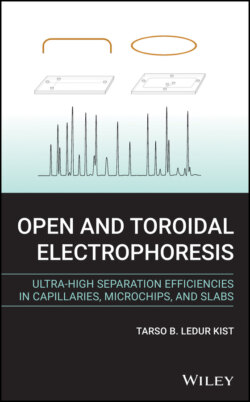Читать книгу Open and Toroidal Electrophoresis - Tarso B. Ledur Kist - Страница 22
1.1.10 Concentration–pH and pa–pH Diagrams
ОглавлениеIt is important to know the concentration of all chemical species present in a given buffer solution at a given pH, because some species may interfere with the migrating analytes under study. Additionally, it is also important to know the concentrations of all existing species of an analyte present in a separation medium at a given buffer pH. This is important because the analyte species present define the average electrophoretic mobility of the analyte, the system peaks, and the interactions of the species with the BGE components. –pH diagrams are one of the most commonly used tools to visualize the concentration of chemical species, showing the concentration of each species at every pH in the range (which is the maximum range used in ESTs). Figure 1.4 shows the –pH diagram of a triprotic acid (0.1 M citric acid in an aqueous solution), which is a complex acid because its successive ionizations produce many species. In Figure 1.4 only the most concentrated species can be seen, as the curves of the most diluted species (with M) run too close to the line at M to be observed. Nevertheless, many detectors (fluorescence and potentiometric) are able to detect species down to M and even lower concentrations. Therefore, sometimes it is desirable to visualize the concentration profiles of species within lower concentration ranges. p–pH diagrams are ideal for this as they show as a function of pH. Figure 1.5 shows the same case as studied in Figure 1.4 (–pH diagram of citric acid at the initial concentration of M), but it is now represented as a p–pH diagram.
Figure 1.4 c–pH diagram of citric acid species in an aqueous solution in the 0 to 14 pH range. 0.1 mol of citric acid was used to prepare 1 L of solution, i.e. M.
Figures 1.4 and 1.5 are nothing more than semi-log and log-log plots, respectively. Figure 1.4 allows the visualization of concentration changes of the main species at (3.13), (4.76), and (6.39). On the other hand, Figure 1.5 allows the visualization of the concentrations of extremely diluted species.
